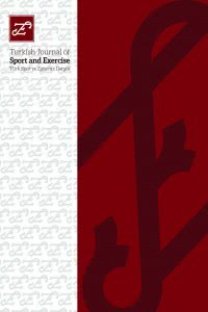Haltercilerde fiziksel yapı ve rölatif kuvvet ilişkisinin araştırılması
Investigation of the relationship between Physical characteristics and relative Strength in Weightlifters
___
- 1. Amatya DL. Anthropometry Physical Fitness Relative Strength and Heart Rate Study of Nepalese Weightlifters. 2008.
- 2. Aydos L, Pepe H, Karakuş H. Bazı Takım Ve Ferdi Sporlarda Rölatif Kuvvet Değerlerinin Araştırılması. Gazi Üniversitesi Kırşehir Eğitim Fakültesi.2004; 5(2):305- 315.
- 3. Castro MJ, Mccann DJ, Shaffrath JD, Adams WC. Peak Torque Per Unit Cross-Sectional Area Differs between Strength-Trained and Untrained Young- Adults. Medicine and Science in Sports and Exercise. 1995; 27(3):397-403.
- 4. Ebada K. Relative strength, Body mass and height as Predictors of Olympic Weightlifting Players Performance. Selçuk Unıversıty Journal of Physıcal Educatıon and Sport Scıence. 2011;13(2): 166-171.
- 5. Ebada K. Growth equation as a mark to the Prediction of Olympic Players results of Weightlifting Sport, in The first scientific conference "sport University in Arab countries from 6-7 Feb 2006: Physical Education of sport - Mansoura University, 2006.
- 6. Ford L, Detterline AJ,Ho KK,Cao WY. Gender- and height-related limits of muscle strength in world weightlifting champions. Journal of Applied Physiology. 2000;89(3): p. 1061-1064.
- 7. Haleczko A. Indices of the Relative Strength Fitness of The Disabled Weightlifters Kinesiology. 2001;11(22): p. 21-25.
- 8. Heyward V. Wagner DR. Applied body composition assessment. 2nd ed. 2004, Champaign, IL: Human Kinetics. 268;2004
- 9. Jackson A, Pollock ML. Practical Assessment of Body- Composition. Physician and Sportsmedicine. 1985;13(5): 76-84
- 10. Kanyevsky V. The Dependence Between the Weightlifter's Absolute and Relative Strength on Weight Class. 2011; Available from: http://www.dynamiceleiko. com/sportivny/library/news/nv006.html.2011
- 11. Mochernyuk V, DragaV. Determining the Dependence between Weightlifting Results in Different Weight Classes. 2001.
- 12. Siahkouhian M, Hedayatneja M. Correlations of Anthropometric and Body Composition Variables with the Performance of Young Elite Weightlifters. Journal of Human Kinetics. 2010; 25:125-131.
- 13. Stone M, Sands WA, Pierce KC, Carlock J, Cardinale M, Newton RU., Relationship of maximum strength to weightlifting performance. Medicine and Science in Sports and Exercise.2005; 37(6):1037-1043.
- 14. Winter E, Maughan RJ. Strength and Cross-Sectional Area of the Quadriceps in Men and Women. Journal of Physiology-London. 1991;438:175-P175.
- ISSN: 1300-9915
- Yayın Aralığı: Yıllık
- Başlangıç: 2018
- Yayıncı: -
Gençlerin serbest zaman aktivitelerine katılamama nedenleri üzerine bir inceleme
Genç basketbolcularda yorgunluğun şut tekniğine etkisi
ADEM CİVAN, İlyas ÖZDEMİR, İsmail TAŞ, Ayhan ÇELİK
İşletmelerde entelektüel sermaye, spor işletmelerine yansımaları ve Marmara Bölgesinde bir araştırma
Haltercilerde fiziksel yapı ve rölatif kuvvet ilişkisinin araştırılması
Latif AYDOS, AHMET UZUN, Raif ÖZEL, Erdinç ESEN
Müsabaka arası içilen maden suyunun serum elektrolit düzeylerine etkisi
ERSAN KARA, MUSTAFA AKIL, IŞIL IŞIK ANDSOY, MURAT ACAT, TUĞBA GÜNGÖR
Futbol hakemlerinin meslek ve aile yaşantılarında karşılaşmış oldukları sorunlar
Onur ALBAYRAK, SERKAN İBİŞ, N. Bahadır KAYIŞOĞLU
Okul yöneticilerinin etik liderlik davranışlarına ilişkin beden eğitimi öğretmenlerinin görüşleri
